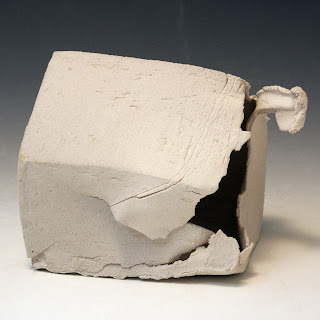When we think of grandmothers, those of
the cookie-baking, sweater-knitting variety typically come to mind.
Not
for Christiane Citron, who was sometimes embarrassed by her bohemian
grandmother.
Christiane
is the granddaughter of Minna Citron, the social realist and abstract artist
featured in the exhibition “Minna Citron: The Uncharted Course from Realism to
Abstraction,” on view at the Georgia Museum of Art until March 3. Christiane
was in town at GMOA recently to attend 90 Carlton: Winter, the open house that
highlighted the exhibition, and to work with students at the University of
Georgia. We were lucky enough to sit down with her and get her thoughts on the
exhibition she helped organize.
 |
Christiane Citron at the Georgia Museum of Art exhibition
Photo courtesy of Christiane Citron |
“She made a big point of saying that
she was an artist who happened to be a grandmother,” says Citron. “I mean, she
didn’t want to be ‘Grandmother Artist,’ so she really had to make a big point about
that. So I would never have called her Grandma or anything. She was always
Minna. I don’t think anybody didn’t call her Minna.”
Bold,
bohemian, feminist and full of creative energy, Minna Citron produced art into
her 90s. She constantly explored new methods of creating and transitioned from
realism to abstraction, serving as one of the first-generation pioneers of
abstract expressionism. “She was an artist,” says Christiane. “She didn’t
really try not to be.”
Christiane
grew up saturated in Minna’s art. She remembers exploring her grandmother’s art
studio as a child, poking through cabinets and drawers filled with bits of
collage supplies.
“Our
whole house was probably filled with Minna’s pictures. So they were just part
of my childhood, you know, living with these pictures here. They represent my
whole sort of personal memories of family and childhood.”
One
of Christiane’s favorite paintings by Minna, which she received as a gift
towards the end of law school, was originally a fixture of her childhood home.
“I
particularly liked the colors. It’s an abstract design and I never knew until
quite a bit after that that the title of that picture—her title of it—is Memories
of Childhood. So it’s kind of ironic because it’s my memories of childhood
too,” she says, smiling. The painting now hangs over the mantelpiece in her
living room.
Christiane
lights up when talking about her grandmother’s artwork, and her passion—and
pride—for Minna’s career is apparent.
“I
admire her integrity in pursuing what she believed in and not becoming stuck in
doing the same thing over and over again,” she says. “And that I’m proud of
her, well I’m very proud of her, but you know I’m proud of the fact of her
personal integrity and that she really was not bending to what some commercial
pressures might be.”
As
the oldest grandchild, Christiane became close to and often spent time with her
grandmother. When she grew older, she became more involved in Minna’s career
and worked on promoting her work.
“I’ve
always felt some responsibility to help promote her because I just thought that
what she did was really neat,” she says.
In
1996, five years after Minna passed away, at age 95, Christiane created an
exhibition in Denver to celebrate the centennial of her grandmother’s birth.
The show was a success, and Christiane hoped eventually to create a traveling
exhibition.
Later, she began working with Jennifer
Streb, an art historian at Juniata College who wrote her dissertation on Minna
Citron. The two women expanded on the 1996 compilation of Minna’s work and,
over the course of about three or four years, created the traveling exhibition
currently at GMOA.
“It’s
a labor of love, and it’s just so gratifying to see people enjoying it and
really interacting with the pictures,” Christiane says.
The
collection of paintings chronicles Minna Citron’s 60-year art career, dating
from 1929 to 1988, presenting social-commentary sketches, abstract collages and
sculptures. When selecting works for the exhibition, Christiane focused on
those she thought would exemplify her grandmother’s work and show the evolution
of her style.
“Even in very late years she was still
very creative and productive and experimenting and so I wanted to be able to
share that with people, to make it be a retrospective. And what I think I’m so
happy about it being here in this wonderful museum because I think she in so many
ways represents the century,” she said. “I hoped
that it would show how she fits into these different developments in American
art history. So I think it really has a lot of educational value to show people
how in one person you can see all those aspects.”
Considering
Minna’s radical, experimental shift in style, “Minna Citron: The Uncharted
Course from Realism to Abstraction” is appropriately titled.
“She
always said to summarize her whole career as the uncharted course. That it
wasn’t like there’s a path that shows you where you’re going to go and where to
go next or turn here and do that. It was experiment. She didn’t know what the
end result would be. And so that’s very brave I think,” said Christiane.
“There’s
something in the stars or synergistic about the way it all worked out that it’s
here,” she says. “Seeing it come together and seeing people interact with it,
that to me is the payoff. I like that. And it’s just really gratifying thinking
how much Minna would enjoy that, to see people interacting with her art.”






